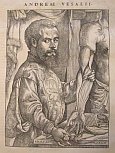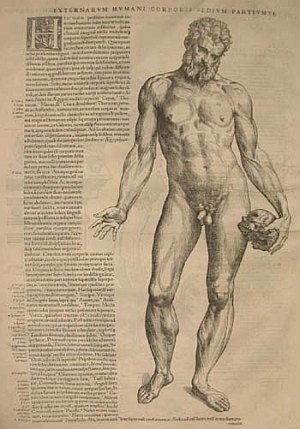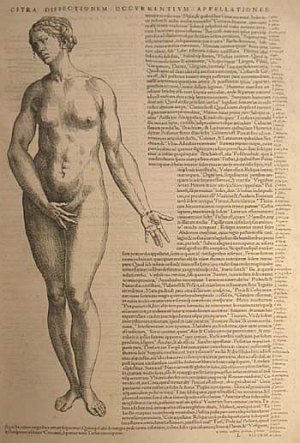In 1543 Andreas Vesalius published his opus De Humani Corporis Fabrica Librorum Septem (Fabrica) and, later the same month, the companion volume De Humani Corporis Fabrica Librorum Epitome (Epitome). The two volumes are considered to be the foundation of modern Anatomy. Vesalius viewed the Epitome as an introduction for the novice in medicine, serving as a pathway to the much larger and more thorough encyclopedic Fabrica. In the rare occasion that either book becomes available for sale at an auction, the bidding is usually fiercely reaching amounts well over a quarter of a million dollars. Among the two, the Epitome is actually considered to be more valuable than the medical opus it was created to introduce.
Andreas Vesalius, the ambitious and self-motivated founder of the new anatomy, was born in Brussels in 1513 to a family of physicians. He attended medical schools at Montpellier and Paris, taught anatomy at Louvain, Padua, Bologna and Pisa, and served as an army surgeon at Charles V, France. Furthermore, when he was just twenty-eight years old in 1543, he published his Fabrica and Epitome in Basle, with the publisher Joannes Oporinus. The books are considered today to be a landmark in medical scientific investigation, as they are one of the first works to display empirical observation combined with accurate descriptive illustrations.
The Epitome, which summarized the whole of anatomy, was published in royal folio (354 x 470 mm) or (14 x 18.5 in) format with 20 leaves, and very few scholarly references. Twelve of the large folio leaves are printed on both sides; another six pages of text are divided into two columns and occupied by large anatomical woodcuts gracefully integrated into the text by the explanatory notes; and two unnumbered leaves printed only on one side. The woodcuts are among the finest artistic engravings of the sixteenth century, and they were intended to be cut out, glued onto parchment and used in the construction of flap-anatomies. The pivotal point of the volume, and the starting point for the medical student, is the nude figures of the male and female. From there, leaf by leaf, the skin is removed to expose the first layer of muscles, followed by drawings of deeper layers of the vascular, the nervous systems and, ultimately, the skeleton.
Probably less expensive to publish than the Fabrica, the Epitome is much scarcer today, despite its much wider publication and distribution. It is known that there are three extant vellum copies in existence, and from a total of 1543 paper copies, an estimated 23 partly incomplete copies have survived the spoiling effects of time and the scissors of owners. On the other hand, the census by Horowitz and Collins (NY, 1943) lists no less than 154 copies of the original 1543 edition of Vesalius’s Fabrica still in existence.
The result, a volume created to facilitate the introduction of another major medical discovery volume, ends up being more valuable, despite having been offered with a much wider publication and distribution in numerous European countries. This is primarily due to the following two factors:
- The Epitome is artistically more appealing with larger plates that are not identical to the plates found in Fabrica. In addition the latter does not include the two woodcuts of the nude male and nude female figures.
- The larger sheets of the Epitome were commonly used as a guide to dissection and were often cut out and mounted on the walls of dissection rooms. This resulted in the reduction of the original printing to a few complete surviving copies.
As for the reason why Vesalius’s books achieved something few medical authors since his time have been able to offer:
- His Illustrations are not just scientifically accurate, but they are also artistically superb.
They are admired for their beautiful layout, easily readable type, high quality paper and a graceful integration of the drawings into the text.



{ 2 comments… read them below or add one }
Hello,
Would you mind pointing me in the direction of your source for when you say there are “an estimated 23 partly incomplete copies” of the Epitome? I can’t find a comprehensive survey of the existing 1543 editions anywhere. Thank you very much!
Some of the information came from Horowitz and Collins and other from the National Library of Medicine.
{ 2 trackbacks }